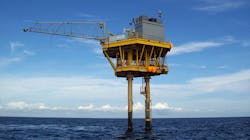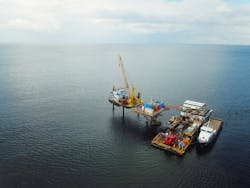OTC 2023: Aquaterra's modular platform minimizes footprint of offshore projects
By Ariana Hurtado, Editor and Director of Special Reports
HOUSTON — Operators are constantly seeking increased efficiency and production optimization, and the Offshore Technology Conference (OTC) provides a wealth of information and technology showcases to help a company find the right service provider for an offshore project.
"Whether oil prices are soaring as they did last year or returning to a lower base mark, operators around the world are still looking for the same thing. Namely, timely and cost-effective routes to production that maximize revenue, local content and minimize expenditure and emissions," Stewart Maxwell, technical director with Aquaterra Energy, told Offshore. "To meet this need, operators require platform designs that minimize build and implementation times and reduce capex, emissions and time to first oil or gas."
In the following Q&A, Maxwell chatted with Offshore about Aquaterra's Sea Swift offshore platform, which was first successfully installed in 2007, and nine have now been installed for various operators around the world. Sea Swift is a modular and adaptable platform that was designed to allow for rapid returns in shallower waters.
OFFSHORE: What are the offshore platform's capabilities and applications?
It’s simplified, modular designs, support reduced steel requirements and focus on using existing logistics and fabrication facilities to keep project expenditure lower and local content opportunities higher.
Due to its modular design, it offers complete fabrication flexibility—its fabrication can be in larger, more established yards or spread across several smaller yards, supporting local content goals while making use of specialist facilities elsewhere—reducing both build and installation costs. Because of this, Sea Swift can also be transported in prefabricated parts and assembled on site like industrial-scale Lego. This means installation can take place using existing in-country infrastructure, such as jackup rigs already in country for drilling, removing the cost and environmental impact of bringing in bigger vessels and cranes to regions.
In today’s industry where minimizing emissions is crucial to supporting the world’s climate goals, this approach can represent a win-win where operators can reduce their emissions and costs while also streamlining timelines to first production.
Sea Swift platforms can also be fully powered by renewable sources, such as wind and solar. Using renewable technologies like wind turbines and solar banks creates a self-sufficient solution that does not require traditional diesel generators for power. This not only significantly reduces the overall lifetime emissions of the platform, but also those that are associated with the ongoing maintenance and logistics for refueling visits.
OFFSHORE: How is Sea Swift different? How have other offshore platforms failed to meet industry needs?
MAXWELL: Platform designs that fail to optimize their efficiency can present operators with a range of drawbacks, from higher costs and emissions, through to slower production and lower returns.
Traditional platform options can contain more steel than a Sea Swift platform, greatly increasing both material costs and manufacturing and shipping emissions. Platforms with reduced flexibility for build and installation can hinder operator options for fabrication and, therefore, local content generation. Furthermore, where Sea Swift can be installed by a jackup rig, more complex platforms require heavy-lift barges for installation, which are highly emission-intensive due to fuel consumption, especially if they must travel long distances between projects.
As an example, mobilization and transportation of a heavy-lift barge from Rotterdam to West Africa would create 3,510 tonnes of CO2e and cost an additional $17 million compared to installation by jackup. This impact is amplified if the platform itself proves to be too complex for local manufacturing and needs to be transported greater distances to site.
OFFSHORE: How did the company develop the technology?
MAXWELL: Sea Swift platforms have been designed to be tailored to the specific needs of each operator and project, regardless of topsides, power requirements or water depth. The platform fundamentals are always the same, but subsea structures and topsides can be mixed and matched to specific development requirements. Platforms can range from a single-well monopile platform to larger multi-well designs, and can be applied in a wide variety of offshore situations, either as a standalone platform or as a bolt-on or tieback to existing production platforms that need extra capacity.
OFFSHORE: Do you have any recent case study details you can share?
The project was installed by a jack-up rig and pioneered a 100% renewable offshore platform which reached first gas within a year of installation, producing up to 40 million cubic feet of gas a day for Trinidad & Tobago’s petrochemicals industry. Fully self-powered, the platform eliminated the need for traditional diesel generators or cables connecting to the grid. Additionally, intelligent monitoring and predictive maintenance enables it to operate unmanned and reduce average maintenance visits, significantly slashing operational expenditure and emissions across its lifecycle.
The platform was fabricated 100% in-country, taking 476,613 hours, of which 66% were local content hours.
As a lightweight, unmanned modular design that is locally made, predictively maintained, and renewably powered, the platform dramatically reduced the cost and carbon emissions of manufacturing, transportation, installation, and maintenance – addressing the industry’s need for efficient and cost-effective platform options which can minimise carbon intensity.
05.03.2023
About the Author
Ariana Hurtado
Editor-in-Chief
With more than a decade of copy editing, project management and journalism experience, Ariana Hurtado is a seasoned managing editor born and raised in the energy capital of the world—Houston, Texas. She currently serves as editor-in-chief of Offshore, overseeing the editorial team, its content and the brand's growth from a digital perspective.
Utilizing her editorial expertise, she manages digital media for the Offshore team. She also helps create and oversee new special industry reports and revolutionizes existing supplements, while also contributing content to Offshore's magazine, newsletters and website as a copy editor and writer.
Prior to her current role, she served as Offshore's editor and director of special reports from April 2022 to December 2024. Before joining Offshore, she served as senior managing editor of publications with Hart Energy. Prior to her nearly nine years with Hart, she worked on the copy desk as a news editor at the Houston Chronicle.
She graduated magna cum laude with a bachelor's degree in journalism from the University of Houston.



